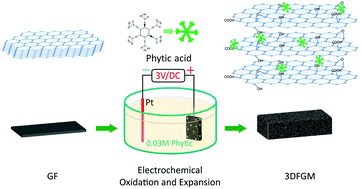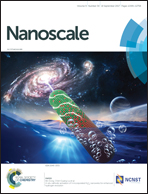Phytic acid-assisted electrochemically synthesized three-dimensional O, P-functionalized graphene monoliths with high capacitive performance†
Abstract
Three-dimensional functionalized graphene monoliths (3DFGMs) have attracted intensive attention as energy storage materials due to their unique interconnected porous structure, good electrical conductivity, excellent mechanical strength, and pseudocapacitive characteristic. Herein, we report a facile, green and low-cost strategy through a simple, one-step electrochemical process in a phytic acid solution to fabricate a 3DFGM. The 3D porous structure and functionalization of graphene can be obtained simultaneously. The as-obtained 3DFGM that consists of 3D porous O, P-functionalized few-layer graphene shows high specific surface area and good electrical conductivity. The 3DFGM with these characteristics exhibits excellent electrochemical performance, including an ultrahigh specific areal capacitance of 485 mF cm−2, superior rate performance, and outstanding cycling stability. Most importantly, the assembled 3DFGM//3DFGM symmetric supercapacitor exhibits a high specific areal capacitance of 225 mF cm−2 and delivers a maximum energy density of 1.2 W h L−1 and a power density of 560 W L−1 in aqueous electrolyte. Therefore, this work provides a promising method for the future design and fabrication of high performance 3D functionalized graphene-based electrodes for energy storage devices.



 Please wait while we load your content...
Please wait while we load your content...